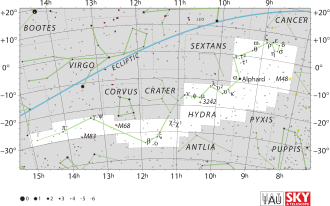R Hydrae
| Stern R Hydrae | |||||||||||||||||||
|---|---|---|---|---|---|---|---|---|---|---|---|---|---|---|---|---|---|---|---|
 | |||||||||||||||||||
| Bild und Illustration der Bugstoßwelle des Sterns R Hydrae. | |||||||||||||||||||
| AladinLite | |||||||||||||||||||
| Beobachtungsdaten Äquinoktium: J2000.0, Epoche: J2000.0 | |||||||||||||||||||
| Sternbild | Wasserschlange | ||||||||||||||||||
| Rektaszension | 13h 29m 42,772s [1] | ||||||||||||||||||
| Deklination | −23° 16′ 52,697″ [1] | ||||||||||||||||||
| Helligkeiten | |||||||||||||||||||
| Scheinbare Helligkeit | 4.97 (3.5 bis 10.9) mag[1][2] | ||||||||||||||||||
| Spektrum und Indices | |||||||||||||||||||
| Veränderlicher Sterntyp | M[2] | ||||||||||||||||||
| B−V-Farbindex | (1.61)[1] | ||||||||||||||||||
| U−B-Farbindex | (0.68)[1] | ||||||||||||||||||
| R−I-Index | (2.42)[1] | ||||||||||||||||||
| Spektralklasse | M6e-M9eS(Tc)[2] | ||||||||||||||||||
| Astrometrie | |||||||||||||||||||
| Radialgeschwindigkeit | (−10.0 ± 0.6) km/s[1] | ||||||||||||||||||
| Parallaxe | (4.47 ± 0.89) mas[1] | ||||||||||||||||||
| Entfernung | (730 +180−130) Lj (220) pc | ||||||||||||||||||
| Eigenbewegung[1] | |||||||||||||||||||
| Rek.-Anteil: | (−46.66 ± 1.45) mas/a | ||||||||||||||||||
| Dekl.-Anteil: | (7.98 ± 1.51) mas/a | ||||||||||||||||||
| Physikalische Eigenschaften | |||||||||||||||||||
| Radius | (630) R☉[3] | ||||||||||||||||||
| Leuchtkraft | |||||||||||||||||||
| Effektive Temperatur | (2100) K[3] | ||||||||||||||||||
| Andere Bezeichnungen und Katalogeinträge | |||||||||||||||||||
| |||||||||||||||||||
R Hydrae (R Hya) ist ein veränderlicher Stern vom Typ Mira im Ostteil des Sternbildes Wasserschlange.
Die Helligkeit von R Hydrae schwankt mit einer Periode, die zurzeit 389 Tage beträgt, zwischen +3,5 und +10,9m.[2] Die Periode von R Hydrae verändert sich langsam. Sie betrug zu Beginn des 18. Jahrhunderts 500 Tage und nimmt seitdem langsam ab.
Der Zeitraum vom Maximum zum Minimum beträgt 198 Tage, der vom Minimum zum Maximum 191 Tage.[4]
Während des Helligkeitsmaximums ist der Stern mit bloßem Auge gut zu sehen, während man im Minimum ein Teleskop von mindestens 5 Zentimeter Objektivöffnung zur Beobachtung benötigt.
R Hydrae ist ca. 730 Lichtjahre entfernt und gehört der Spektralklasse M an. Der Stern hat mit etwa 2100 K eine sehr geringe Oberflächentemperatur.[3]
Weblinks
- http://stars.astro.illinois.edu/sow/rhya.html
- https://www.aavso.org/vsx/index.php?view=detail.top&oid=15960
Einzelnachweise
- ↑ a b c d e f g h R Hya. In: SIMBAD. Centre de Données astronomiques de Strasbourg, abgerufen am 9. September 2018.
- ↑ a b c d R Hya. In: VSX. AAVSO, abgerufen am 8. September 2018.
- ↑ a b c d E. De Beck, L. Decin, A. De Koter, K. Justtanont, T. Verhoelst, F. Kemper, K. M. Menten: Probing the mass-loss history of AGB and red supergiant stars from CO rotational line profiles. II. CO line survey of evolved stars: Derivation of mass-loss rate formulae. In: Astronomy and Astrophysics. 523. Jahrgang, 2010, S. A18, doi:10.1051/0004-6361/200913771, arxiv:1008.1083, bibcode:2010A&A...523A..18D.
- ↑ Mira Predictions - 2019. In: britastro.org. 2019, abgerufen am 22. Juni 2019.
Auf dieser Seite verwendete Medien
Opaque red circle
This image from the Spitzer Space Telescope (left panel) shows the "bow shock" of a dying star named R Hydrae (R Hya) in the constellation Hydra.
Bow shocks are formed where the stellar wind from a star are pushed into a bow shape (illustration, right panel) as the star plunges through the gas and dust between stars. Prior to this image one had never been observed around this particular class of red giant star. Our own Sun has no bow shock, only a bow wave.
R Hya moves through space at approximately 50 kilometers per second. As it does so, it discharges dust and gas into space. Because the star is relatively cool, that ejecta quickly assumes a solid state and collides with the interstellar medium. The resulting dusty nebula is invisible to the naked eye but can be detected using an infrared telescope.
This bow shock is 16,295 AU from the star to the apex and 6,188 AU thick. 1 AU is the distance between the Sun and the Earth. The mass of the bow shock is about 400 times the mass of the Earth.
The false-color Spitzer image shows infrared emissions at 70 microns. Brighter colors represent greater intensities of infrared light at that wavelength. The location of the star itself is drawn onto the picture in the black "unobserved" region in the center.Autor/Urheber: IAU and Sky & Telescope magazine (Roger Sinnott & Rick Fienberg), Lizenz: CC BY 3.0
IAU Hydra chart



